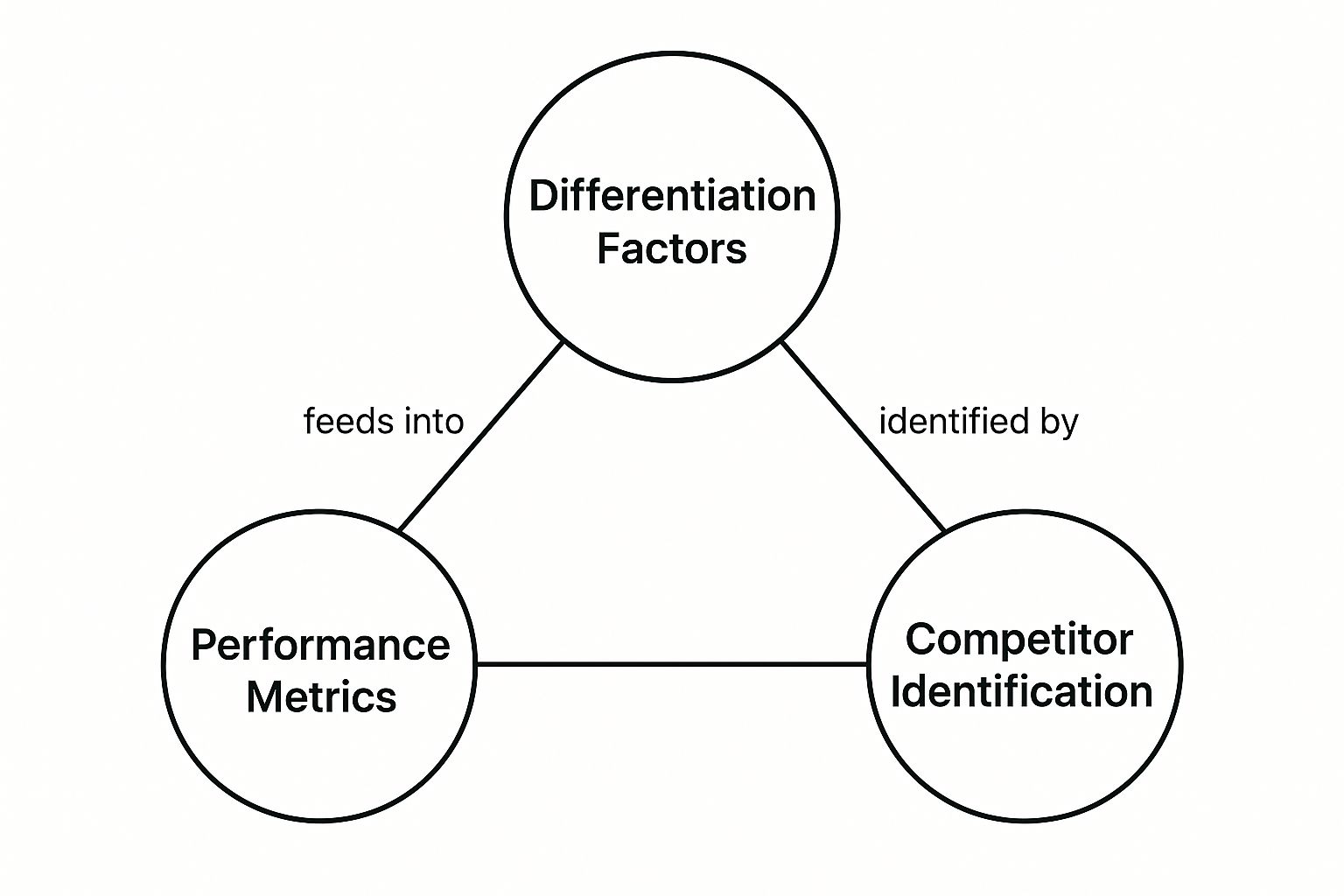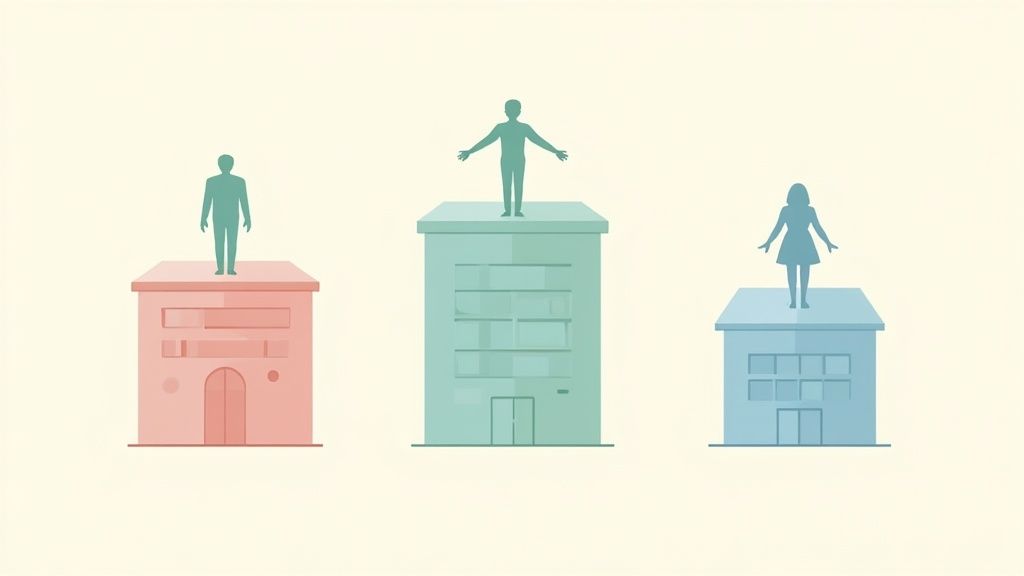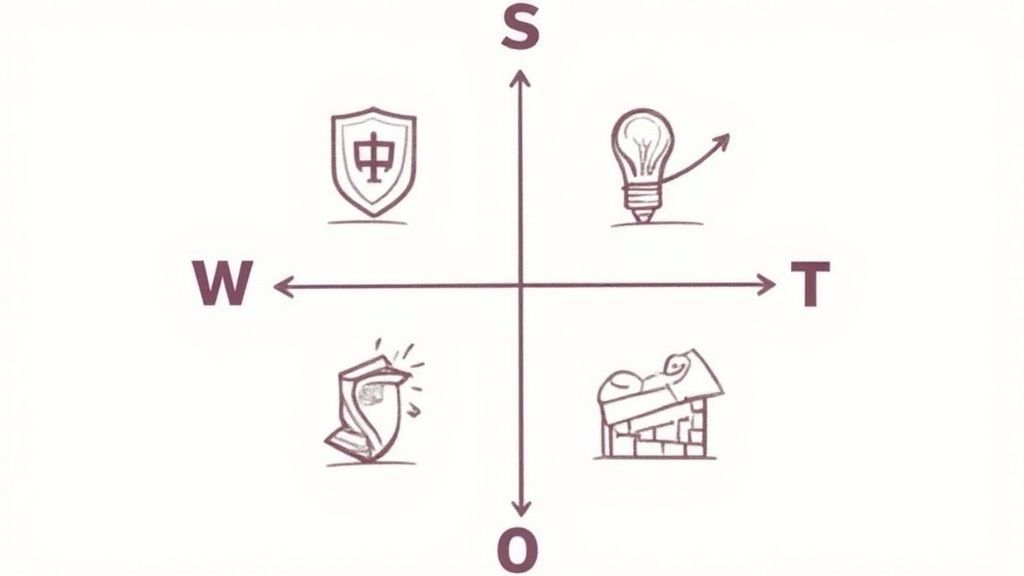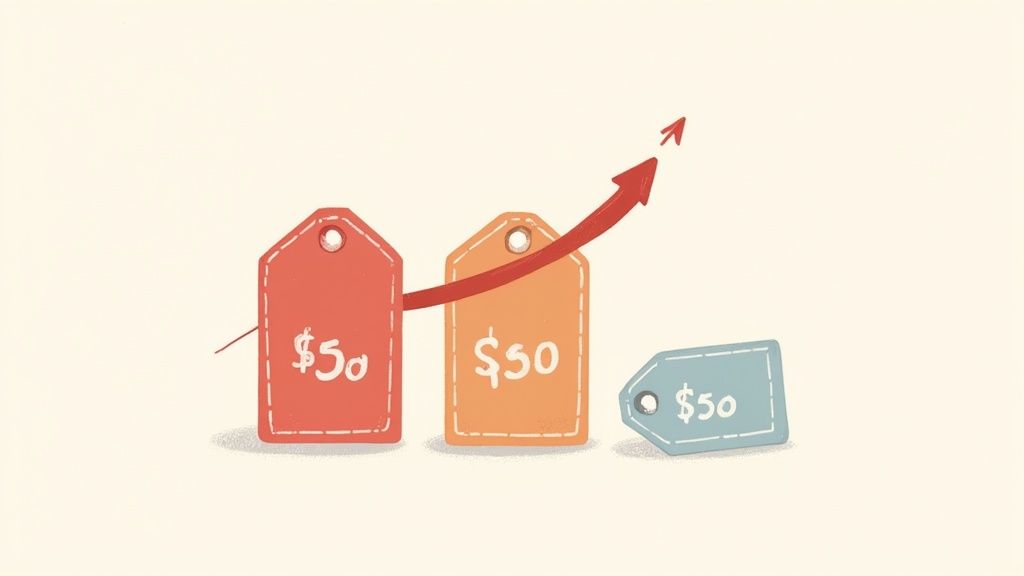Hotel Competitive Analysis: Master Market Intelligence
June 15, 2025

Mapping Your True Competition Beyond The Obvious

The infographic above shows how connected competitor identification, performance metrics, and your unique selling points are in a hotel competitive analysis. These three things are the heart of a strong strategy. Sure, identifying your competitors is important, but it's just the first step. Understanding how they perform and what makes you different is what really lets you stand out.
So, let's talk about identifying those competitors. Many hoteliers only focus on the obvious – other hotels in the same area and category. But your real competition is much wider than that.
Think about it: a luxury resort might see other high-end hotels as its main rivals. But they could be losing guests to fancy villa rentals or even luxury cruises that offer similar experiences. Put yourself in the guest's shoes. What are they really after? Relaxation? Adventure? A special cultural experience? These desires often go beyond typical hotel categories.
This means a boutique hotel downtown isn't just competing with other boutique hotels. They're also up against trendy Airbnbs, serviced apartments, and even charming B&Bs that offer a personal touch. Plus, things like changing travel trends and new technologies can bring in totally new competitors. For instance, the rise of “bleisure” travel (business and leisure combined) mixes up traditional guest segments. Understanding these details is key for a smart hotel competitive analysis.
A Real-World Example
Here’s a story from my own consulting experience. I was working with a family-friendly resort that was baffled by dropping bookings. They had carefully analyzed their direct competitors (other family resorts) but couldn't figure it out. After some digging, we realized they were losing business to all-inclusive cruise packages. These cruises offered similar kid-friendly activities, dining, and even childcare, often at a lower total price. This realization helped the resort refresh their offerings and marketing to highlight what made them special. They started offering their own all-inclusive packages and focused on the advantages of a resort vacation over a cruise. You can check out more competitive analysis features on Ranova. The global hotel market is huge, expected to hit $443.07 billion by 2025. See more on Statista. This growth shows just how important it is to stand out from the crowd.

This screenshot from STR, a top source for global hospitality data, shows an example dashboard of key performance metrics. These metrics, like occupancy rates and RevPAR, are essential for comparing your hotel to the competition. Using tools like this gives you valuable data to spot market trends, adjust your pricing, and improve your overall performance. By looking at the bigger picture of who you’re competing with, you’ll be ready to anticipate market changes and make smart choices.
To help categorize your competitors, think about building a framework like this:
Competitor Categorization Framework
Classification system for identifying and organizing different types of competitors based on market positioning and guest segments
This table helps organize the different kinds of competitors you might face, from direct rivals to those offering alternative experiences. Thinking about "Threat Level" can help you prioritize your analysis and strategy. By mapping out your competition this way, you’re getting a much clearer picture of the market and where your hotel fits in.
Intelligence Gathering That Actually Moves The Needle

This screenshot from Revinate showcases a platform designed to collect and analyze guest feedback. This kind of tool is essential for understanding what guests truly value, giving you a crucial edge in your hotel competitive analysis. Being able to track guest sentiment and operational efficiency can help you identify areas where your competitors might be stumbling.
Let's ditch the late-night scrolling through endless competitor websites. Instead, let's talk about smarter ways to gather competitive data for your hotel. Experienced revenue managers use targeted tools and techniques, and you can too. Remember, this isn't about copying; it's about understanding.
Tracking Pricing and Promotions
One key aspect of intelligence gathering is systematically tracking competitor pricing and promotions. You could set up alerts, for example, to notify you of price changes or special offers. This allows you to respond strategically, not reactively, avoiding those knee-jerk reactions that can eat into your profits.
Also, don't underestimate the power of social media listening and review analysis. Tools like Revinate (pictured above) offer valuable insights into guest satisfaction. This lets you see what guests really love (or hate) about the competition.
Ethical Considerations
A quick word on ethics: stick to publicly available information and avoid anything that feels even remotely shady. No fake bookings or posing as a guest to snoop around. Trust me, there are plenty of legitimate ways to gather valuable intel.
The global hotel industry is booming, with RevPAR projected to increase and new hotels opening worldwide. Check out Hospitality Insights for more on this. This growth makes robust competitive analysis more critical than ever.
Free and Low-Cost Intelligence Tools
You don't need to break the bank for effective competitive intelligence. Plenty of free and low-cost options provide professional-grade insights. Google Alerts, for instance, can notify you of competitor mentions online. Most social media platforms have basic competitive tracking built into their analytics dashboards. And of course, you can always check out free review sites to gauge guest sentiment. Expensive platforms may have more bells and whistles, but they aren't always essential, especially when you're starting out.
A simple spreadsheet can be surprisingly effective. Create categories for pricing, promotions, guest satisfaction, and online reputation. This keeps your data organized and helps you spot trends and patterns. Remember, the goal is actionable intelligence, not massive, unwieldy spreadsheets.
Before we go any further, I want to share a handy table I've put together. It lists some excellent resources for gathering competitive intelligence, along with information on cost, reliability, and how often they're updated.
To get you started, here’s a helpful table outlining various data sources for your hotel competitive analysis:
This table gives you a starting point for thinking about the different kinds of information available and where to find it. Remember, reliability and update frequency can vary, so it's good to use a mix of sources.
By focusing on collecting relevant data and using the right tools, you can transform your hotel competitive analysis from a tedious task into a valuable source of strategic advantage.
Benchmarking Performance Without Getting Lost In Data

This screenshot from STR's Data Insights page gives you a taste of the data you can get your hands on for competitive analysis. Seeing key metrics like occupancy and RevPAR laid out like this helps you see how your hotel stacks up against the competition and the market overall. Trust me, having this kind of data is essential for figuring out where you stand and where you can grow.
So, you've done the legwork and gathered intel on your competitors—pricing, promotions, what people are saying online. Great! But now what? A mountain of raw data is useless without context. That's where benchmarking comes in. Benchmarking helps you turn that raw data into something you can actually use. Think of it like having all the ingredients for a cake but no recipe. Benchmarking is the recipe.
Beyond Basic Metrics
RevPAR is a good starting point, sure, but don't stop there. You should also be looking at guest satisfaction scores, online reputation metrics, and how efficient your operations are. For example, how fast are your competitors responding to online reviews? How long does it take guests to check in and out?
These might seem like small things, but they can have a big impact on how guests see your hotel – and that affects your bottom line. For a deeper dive into hotel KPIs, check out this article: KPI for Hotels.
I remember working with a hotel that was completely fixated on RevPAR but ignored their online reputation. They had a competitor with slightly lower RevPAR, but consistently higher occupancy. Why? The competitor had amazing online reviews. They focused on giving guests a fantastic experience, which led to positive online buzz and, ultimately, more bookings. That hotel learned a valuable lesson about looking beyond the basics.
Creating Meaningful Comparisons
Benchmarking isn't a one-size-fits-all thing. You have to think about things like seasonal changes, what's happening in the market, and what makes your property unique. If you're a budget-friendly hotel, comparing yourself to a luxury resort isn't going to tell you much. Focus on competitors that are similar to you.
Also, remember that the market is always changing. What worked last year might not work this year. So, keep your benchmarking flexible and update it regularly. This helps you adapt to the ever-shifting competitive landscape and stay ahead of the game. Speaking of market dynamics, the global hotel market is expecting a lot of investment growth in 2025. You can discover more insights on JLL. This just shows how important it is to stay competitive and use data to your advantage.
Identifying Opportunities
If you're doing benchmarking right, it will show you where you're falling short and where you have opportunities to improve. Are your competitors killing it in areas where you’re lagging? Are they missing something that you can capitalize on? These are golden opportunities to stand out and grab some market share.
Once you've spotted those opportunities, set realistic goals. Don’t try to double your RevPAR overnight. Focus on small, achievable improvements. These small wins build momentum and create a culture of continuous improvement. Remember, benchmarking isn't just about catching up; it's about finding what makes you special and becoming a leader in your market.
Finding Your Competitive Edge In Crowded Markets
This screenshot from Google Travel shows just how much information potential guests can see at a glance. Pricing, reviews, amenities, photos… travelers can compare properties in seconds. This highlights why a strong online presence and understanding what influences bookings (through a hotel competitive analysis) is so important.
So many hotels just copy what their competitors are doing. Competitor A offers free breakfast? Suddenly everyone has free breakfast. But the hotels that really thrive? They don't copy—they innovate. They find the gaps, the things competitors are missing, and use those insights to create something special.
This means looking beyond the obvious. Your competitor might have a slightly higher RevPAR, but are they handling negative reviews well? Are they addressing complaints about slow Wi-Fi or limited food options? These small details can be huge opportunities for you.
For example, I once worked with a city-center hotel struggling against a nearby luxury chain. Instead of trying to match the chain's fancy amenities, they focused on what they could do: a hyper-local experience. Partnering with local businesses, they offered curated neighborhood tours and highlighted the area's unique character. This authentic approach resonated with guests looking for something more than just a standard hotel stay, and their bookings took off.
Turning Weaknesses into Opportunities
Here are a few ways smart hoteliers use hotel competitive analysis to gain an edge:
- Identify Underserved Guest Segments: Maybe your competitors focus on business travelers. This could leave an opening for you to cater to families or solo adventurers.
- Focus on Overlooked Amenities: Everyone might offer a pool, but what about a rooftop garden with city views? Think about what amenities truly resonate with your ideal guest.
- Close Service Gaps: Are competitors getting slammed for slow check-in or unhelpful staff? Create a seamless, positive guest experience and you'll stand out.
Leveraging Competitive Analysis in Marketing
A solid hotel competitive analysis influences everything from renovations to your marketing. If your competitors are all pushing luxury, maybe you position yourself as the trendy, budget-friendly choice. The key is clearly communicating your unique advantages.
Don't just tell guests you're different – show them. Use high-quality photos and videos to showcase what makes you unique. Highlight glowing guest reviews that emphasize your strengths. And remember the power of storytelling. Sharing authentic stories that connect with your target audience can be far more effective than a generic list of amenities.
Even competitor strengths can be your opportunity. Let's say a competitor is known for their spa. You might not be able to build an identical spa, but perhaps you can partner with a local one to offer discounted treatments to your guests. This lets you provide a similar benefit without a huge investment.
By analyzing competitor weaknesses and guest feedback, you can discover real opportunities to stand out. That's how you build loyal guests and a lasting competitive advantage in a crowded market.
Mastering Competitive Pricing Without Starting Rate Wars

This Booking.com screenshot gives you a glimpse into how guests see your hotel alongside your competition, and more importantly, how your prices stack up. This is a core piece of your hotel competitive analysis. This data is pure gold – it tells you exactly where you stand in the market and how to tweak your pricing for maximum bookings.
Pricing. It's the nitty-gritty of hotel competitive analysis, and where things can get messy. Destructive rate wars can break out, but seasoned revenue managers know the secret: how to keep an eye on the competition without triggering a price freefall. Let me share some insights.
Understanding Dynamic Pricing
First things first: hotel pricing isn't a set-it-and-forget-it deal. It's a living, breathing thing. Your competitors are constantly changing their rates based on demand, the time of year, even the day of the week. Checking their prices once just isn't enough.
You need to monitor those shifts. Don't worry, this doesn't mean glued to your screen 24/7. Smart tools and automated alerts will be your best friends here, notifying you of any major changes.
Finding Your Optimal Rate Position
Where do your rates fit in? Are you going for budget-friendly, somewhere in the middle, or full-on luxury? Your pricing needs to match your brand and the value you offer. A budget hotel with basic amenities can't charge premium prices. But on the flip side, constantly undercutting the competition when you've got something special to offer will eat into your profits.
Spotting Competitor Pricing Errors
Everyone makes mistakes, even your competitors. Sometimes they’ll overreact to a slow period and drop their prices too much, or maybe they miss the memo about a local event that’s driving up demand. These are golden opportunities.
If a competitor slashes their prices and you know you offer a comparable (or better) experience, hold your ground. You might just snag guests who prioritize quality over saving a few bucks.
I remember one slow season, a competitor dropped their rates by a whopping 50%. Instead of panicking, we kept our rates steady and highlighted our superior amenities and service in our marketing. Guess what? Bookings actually went up. Guests saw the value and were happy to pay a little more.
Monitoring Promotions and Packages
Don't just focus on the basic room rate. Keep tabs on your competitors' promotions and packages. Are they offering discounts for longer stays, or bundling deals with local attractions or restaurants? These things can be a major deciding factor for guests.
You don’t always have to match them, but you do need to know what they’re offering. Maybe you create your own unique package, or highlight a different aspect of your hotel that appeals to a different type of traveler.
Responding Strategically, Not Reactively
The golden rule is to be strategic, not reactive. Don’t just blindly follow the competition. Analyze their moves. Why are they making these changes? What are they trying to accomplish? Understanding the context helps you make smart decisions that support your own revenue goals.
Sometimes, the best move is no move at all. If a competitor’s pricing strategy doesn't make sense for your target market or your brand, stick to your plan and focus on what makes your hotel special. Mastering competitive pricing is a complex game. It's all about understanding your market, finding the sweet spot for your rates, and making informed decisions that boost revenue without sacrificing profit.
Transforming Analysis Into Winning Hotel Strategy
This TripAdvisor screenshot shows just how much competitor info is out there—everything from guest reviews and photos to pricing. It’s a goldmine for hotel competitive analysis, giving you a real-time snapshot of how your property stacks up against the competition. Trust me, analyzing this data can reveal some serious areas for improvement and opportunities to make your hotel stand out.
Gathering this intel is only the first step. The real magic happens when you turn that data into a winning strategy. Think of your hotel competitive analysis like putting together a puzzle. You have all the pieces (the data), but you need the picture on the box (your strategy) to guide you.
Prioritizing Improvement Opportunities
Let’s be real, not all improvements are created equal. Some will give you much more bang for your buck than others. I always prioritize changes based on three things: competitive gaps, guest impact, and available resources.
For example, if every competitor offers free Wi-Fi and you don’t, that's a big competitive gap. If guests constantly complain online about slow internet, that's a high guest impact. If upgrading your Wi-Fi is within your budget, boom—that’s a high-priority improvement.
But what if a competitor has a rooftop pool, but your property simply doesn't have the space? That’s a lower priority, even if guests rave about it. Focus on what's actually doable. Maybe you can spruce up your existing pool area with comfy lounge chairs and better food and beverage service.
Cascading Insights Across Departments
A winning competitive strategy needs everyone on board, not just the revenue manager. Share your hotel competitive analysis with marketing, sales, operations, and guest services. It’s all about a unified approach.
Let’s say your competitors are playing up their family-friendly amenities. Your marketing team can target families in their campaigns. Operations can make sure kid-friendly options are easy to find, and guest services can offer personalized welcome gifts for kids. See how that works?
Creating Sustainable Systems
Competitive analysis isn't a one-and-done project. It's an ongoing process. Set up systems for regular monitoring and strategy tweaks. Think of it like gardening—you need to regularly weed, water, and prune to keep things thriving. Set alerts for competitor price changes, keep tabs on guest reviews, and revisit your strategy at least quarterly. This keeps you nimble and ready to adapt to the ever-shifting hospitality landscape. For more on managing your online presence, check out this post on Hotel Reputation Management.
Presenting Competitive Findings to Stakeholders
Getting buy-in for new ideas means making compelling presentations. Focus on how your competitive strategy directly affects business goals. Use visuals, like charts and graphs, to highlight key findings and show potential ROI. Don't just present data; tell a story. Explain how your strategy will improve the guest experience, boost your brand, and ultimately bring in more revenue. By showcasing the value of your hotel competitive analysis, you'll get more support for your strategic initiatives. This collaborative approach, combined with regular monitoring and adjustments, transforms your competitive analysis from a static report into a powerful tool for continuous improvement and long-term success.
Key Takeaways
That video gives a solid overview of competitive analysis – good groundwork for putting these ideas into practice. Let's recap the essentials of effective hotel competitive analysis and how it all translates into tangible results.
Actionable Competitive Analysis Techniques
Remember, your competition isn't just the hotel across the street. Think about other places people might stay or experiences they might choose instead of your hotel, especially those targeting similar guests. Don't get stuck on just price and location. Really dig into online reviews and social media chatter to understand what truly drives booking decisions. Tools like Revinate can help uncover those hidden gems. Gathering good intel means tracking competitor pricing, promotions, and guest sentiment—ethically, of course. Even simple spreadsheets combined with free tools like Google Alerts can be surprisingly powerful.
Critical Warning Signs and Success Metrics
Benchmarking is key. Don't just obsess over RevPAR. Look at other metrics, too, like guest satisfaction, your online reputation, and how efficiently you run things. I’ll never forget this one hotel, totally fixated on RevPAR, completely ignoring their terrible online reviews. Their competitor, with slightly lower RevPAR but amazing reviews, actually had higher occupancy. That really drives home the need for a big-picture view. Pay attention to patterns in competitor pricing and promotions. Are they responding to market shifts, or are they making unforced errors? Are there guest segments they’re missing, or amenities they’re overlooking that you can capitalize on? This is where you find your competitive edge. Don't copy – innovate. Pricing is where analysis turns into action. Get a handle on dynamic pricing and figure out your optimal rate. Don’t get pulled into rate wars. Respond strategically, not emotionally, to your competitors' pricing moves.
Turning Insights into Action
Finally, turn those insights into a winning strategy. Prioritize improvements based on where you see competitive gaps, the impact on your guests, and the resources you have available. Share these insights across all your departments so everyone’s on the same page. Set up systems to keep monitoring your competition and adjust your strategy regularly. Remember, hotel competitive analysis is an ongoing process, not a one-time deal.
Ready to boost your hotel's performance with data-driven insights and streamlined reputation management? Explore Ranova today and discover how AI can help your team improve guest satisfaction, elevate your online reputation, and drive sustainable revenue growth.
Start now and turn guest feedback into
unmatched
experiences
.png)
.svg)
.svg)

